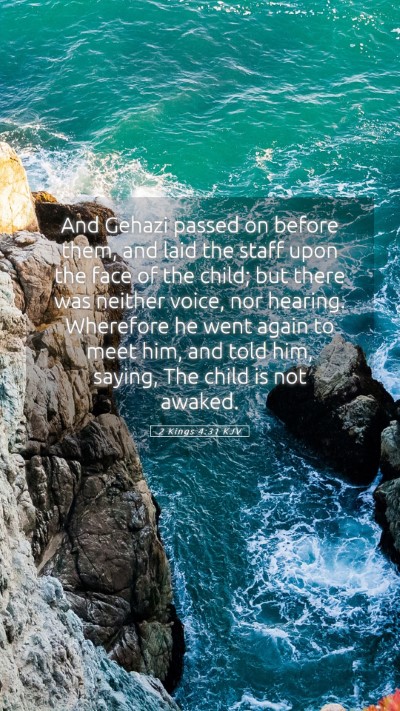Understanding 2 Kings 4:31
Bible Verse: 2 Kings 4:31
When Elisha reached the house, there was the boy lying dead on his bed.
Summary of the Verse Meaning
2 Kings 4:31 presents a poignant moment in the narrative of Elisha, the prophet, highlighting themes of desperation, faith, and the miraculous. In this verse, we witness Elisha arriving at the home of the Shunammite woman, where her son has died. The emotional weight of this event captures the deep sorrow of a mother and the gravity of a prophet's mission to bring hope and restoration.
Insights from Public Domain Commentaries
-
Matthew Henry's Commentary:
Henry emphasizes the unwavering faith of the Shunammite woman, who, despite her tragedy, sought out Elisha. He opines that her actions reveal a profound understanding that God could intervene even in the face of death. This preparation for a miracle underscores the importance of steadfast faith and reliance on God's power.
-
Albert Barnes' Notes:
Barnes interprets the situation as a critical test of faith, where the Shunammite's resolve shows her belief in God’s capacity for restoration. He explores the implications of death in the biblical narrative, asserting that while physical death is inevitable, it is not beyond God's ability to reverse. The mention of the boy lying dead reinforces the severity of their circumstance but also sets the stage for the miraculous intervention expected from Elisha.
-
Adam Clarke's Commentary:
Clarke delves into the emotional landscape surrounding the verse, suggesting that the Shunammite woman's grief is palpable. He notes that her determination to find Elisha indicates not just desperation, but also an ingrained hope that transcends her immediate despair—a hope firmly rooted in her previous experiences of God's provision through the prophet.
Thematic Significance
This narrative signifies several key themes:
- Faith in Adversity: The Shunammite woman's decision to seek Elisha in her hour of need underscores a central tenet of biblical faith—turning to God amidst life’s greatest trials.
- Miracle and Restoration: This moment foreshadows the miracle of resurrection, reinforcing the belief that God holds power over life and death, which is crucial in both the Old and New Testaments.
- Role of Elisha: Elisha’s role as a prophet who performs miracles serves as a representation of God’s ongoing presence and intervention in human suffering.
Related Bible Cross References
- 1 Kings 17:17-24: The account of Elijah and the widow of Zarephath, who also experienced the miracle of restoring her dead son.
- 2 Kings 4:35: Elisha’s direct intervention, leading to the boy’s revival, illustrating God's miraculous power.
- John 11:1-44: The New Testament story of Lazarus, which parallels themes of death and resurrection.
- Matthew 9:18-26: The healing of a ruler’s daughter, where faith meets divine intervention.
- Mark 5:21-43: The restoration of life, emphasizing the theme of faith acknowledged by Jesus.
- Luke 8:49-56: Another example where Jesus raises a dead girl, focusing on faith and hope.
Conclusion
The passage of 2 Kings 4:31 provides rich material for bible study insights and Bible verse commentary. It invites readers to explore the depth of their faith in confronting life's challenges, understanding the miraculous nature of God's promises. This verse is relevant for bible study groups and serves as a catalyst for discussions around understanding Scripture in everyday life.
Further Study Suggestions
- Consider how the themes of resurrection appear throughout Scripture.
- Examine the role and significance of prophets in the Old Testament.
- Reflect on personal experiences of faith in times of crisis, drawing parallels to the Shunammite woman's journey.


